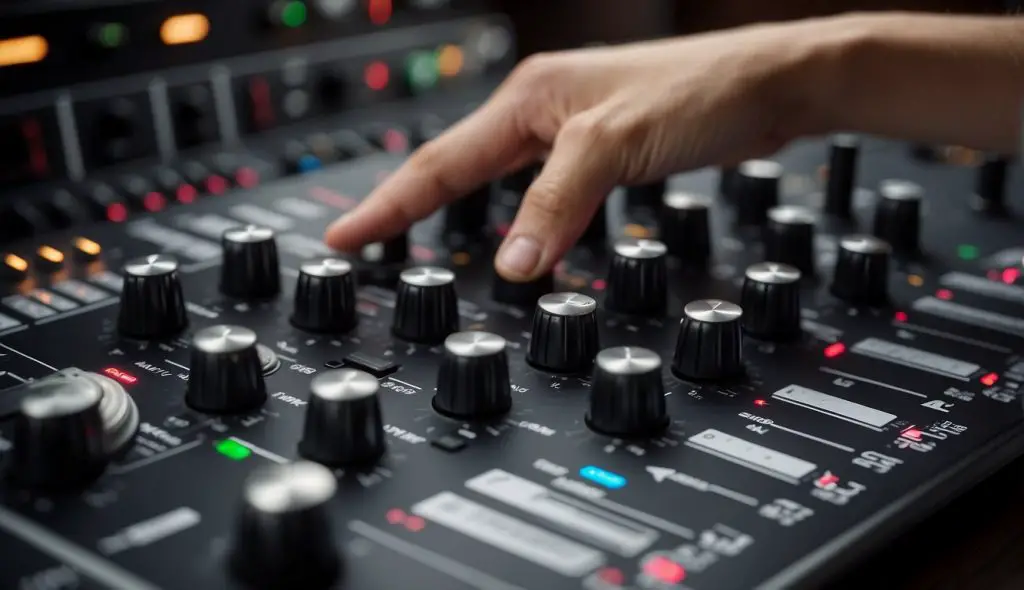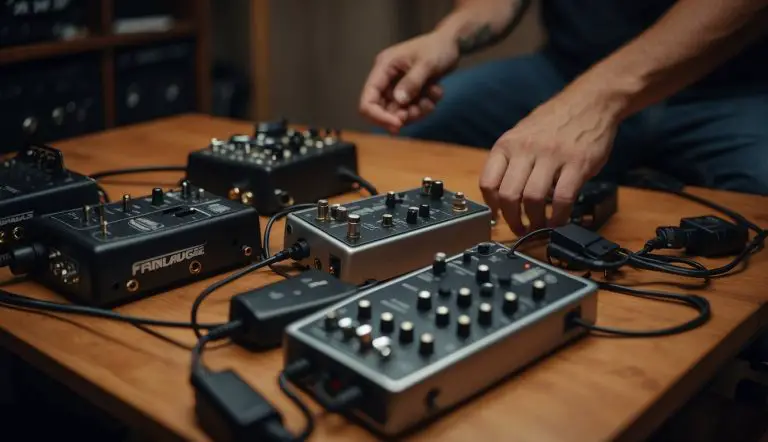How to Use Audio Pass Filters: Simplifying Sound Filtering Techniques
Audio pass filters are critical tools in both audio production and engineering. They allow users to manipulate sound by selectively allowing certain frequencies to pass through while attenuating others.
The basic types of audio pass filters include low-pass, high-pass, band-pass, and all-pass filters. Each has a unique role in shaping the audio signal.
A low-pass filter, for instance, will let low-frequency signals pass and attenuate the high-frequency ones. This makes it useful for smoothing out a sound or reducing noise. High-pass filters, on the other hand, do the opposite, removing low-frequency rumble or hum from recordings.

Implementing audio pass filters can profoundly impact the clarity and quality of audio content. For sound engineers and enthusiasts alike, mastering the use of these filters is essential for tasks such as isolating speech from a noisy background, enhancing musical instruments within a mix, or even creating special sound effects.
With the advent of digital audio workstations and readily available audio processing software, applying audio pass filters has become an accessible and integral part of audio production. Understanding when and how to apply each type of filter ensures a cleaner, more defined final product.
Key Points
- Audio pass filters control which frequencies are allowed through in a signal.
- Different filters serve specific roles in shaping sound, like isolation or noise reduction.
- Mastery of these filters enhances audio production quality.
Table of Contents
The Lowdown on Audio Pass Filters
In my experience, audio pass filters are essential tools for shaping the sounds in audio production by selectively controlling specific frequencies.
Basics of Audio Filters
Audio filters are critical in managing and manipulating an audio signal’s frequency content. A fundamental principle is that every sound comprises multiple frequencies, some dominant and some subtle. Filters allow me to enhance or diminish certain frequencies, which can drastically change the character of the sound.
Types of Audio Pass Filters
There are three primary types of audio pass filters, each serving a different purpose:
- Low-Pass Filters: These allow frequencies below a certain cutoff point to pass through and attenuate frequencies above it. I often use them to remove high-frequency noise or to make a sound “warmer.”
- High-Pass Filters: Conversely, they let through frequencies higher than their set cutoff and cut out the lower ones. I find them useful for eliminating rumble or low-frequency hum in a recording.
- Band-Pass Filters: These allow a specific frequency range to pass while attenuating frequencies outside that range. They help me isolate particular sounds within a mix.
How Audio Pass Filters Work
When I apply an audio pass filter to a track, it alters the balance of its harmonics. For example:
- With a low-pass filter, I can eliminate the harshness from a vocal or reduce the brittleness of a digital synth by filtering out the high-end frequencies. This lets the lower, warmer tones become more prominent.
- If I’m dealing with a muddy mix, I’ll use a high-pass filter to clean up the low-end by removing unnecessary bass frequencies that could be cluttering the sound.
Implementing Audio Pass Filters
When setting up audio pass filters, it’s essential that I select the right type of filter, establish the necessary cutoff frequencies, adjust quality factors, and use equalization techniques effectively. Each decision shapes the character and clarity of the audio signal in unique ways.
Filter Selection
When I begin, my first step is choosing between a low-pass filter, high-pass filter, band-pass filter, or notch filter. My choice depends on what elements of the audio I’m aiming to isolate:
- Low-Pass Filter: Cuts out high frequencies, letting low frequencies pass through.
- High-Pass Filter: Eliminates low frequencies, permitting highs to pass.
- Band-Pass Filter: Allows a range of frequencies to pass while cutting off those outside this range.
- Notch Filter: Targets and removes a specific, narrow frequency range.
Setting Cutoff Frequencies
Once I’ve picked the filter type, I establish the cutoff frequencies. These are the points where I decide how much of the frequency spectrum should be attenuated:
- Low-Pass Cutoff: The highest frequency allowed before attenuation.
- High-Pass Cutoff: The lowest frequency permitted before attenuation.
- In a DAW or with audio tools, I can often set this using a simple interface or plugin.
Adjusting Q and Slope
The Q factor and slope are critical to shaping how the filter behaves around the cutoff point:
- Q Factor: Adjusting the Q, or quality factor, changes how peaked or gentle the filter’s response is at the cutoff.
- Slope: The slope, expressed in dB/octave, defines how sharply the filter attenuates frequencies beyond the cutoff.
- A steeper slope means more aggressive filtering, which can be useful in certain mixing scenarios.
Incorporating EQ Techniques
Finally, using EQ techniques can refine or complement the filtering:
- Shelf Filter: If I need to adjust a broad frequency range up or down after filtering, a shelf EQ is useful.
- Peak: Sometimes after filtering, certain frequencies might peak unexpectedly, and they can be managed with a targeted EQ adjustment.
- Technique: It’s key to use these tools with precision and remember that slight adjustments can have a significant impact on the mix.
Applying Filters in Production
When I craft a mix, my aim is to ensure each element stands out with optimum clarity. Strategic use of audio filters plays a crucial role in achieving this. Here’s how I integrate filters into production, broken down into specific techniques and purposes.
Mixing Techniques
In my experience, mixing is all about balance. I often use high-pass filters to remove low-frequency rumble that can muddy the mix. This is particularly useful for tracks that don’t contribute to the low end, allowing me to leave more room for bass instruments. For vocals, a gentle high-pass filter can eliminate plosives and mic handling noise.
Conversely, low-pass filters target high-frequency noise. These can be essential for taming overly bright cymbals or reducing the harshness from synthetic sounds. I apply these filters with caution to preserve the integrity of the high frequencies, ensuring mix clarity and texture remain intact.
Enhancing Clarity and Space
To make my mix more spacious and clear, I look at the stereo field and frequency spectrum. Filters help me:
- Carve out specific frequencies to reduce clashes, which clears up space.
- Use automation to apply filters dynamically, accentuating the movement and energy in the mix.
By high-pass filtering reverb sends, I avoid low-end buildup, which can otherwise make the mix feel cluttered. This promotes a sense of space without sacrificing the overall warmth.
Addressing Common Audio Issues
Throughout the mixing stage, my aim is to resolve issues before they compromise the final product. If there’s unwanted noise in a recording, I’ll insert a notch filter to surgically remove it. This keeps the rest of the frequencies untouched.
For live recordings, where headroom is frequently challenged by bursts of energy, strategic filtering can provide more headroom without drastically altering the original sound. I’ll do this by setting up filters to control resonant peaks and smooth out the overall response.
Technical Considerations and Advanced Usage
In this section, I’ll dive into the finer points of audio pass filters, from how to thoroughly analyze frequency responses to innovative applications in sound design. Understanding these concepts will help you manipulate audio with precision and creativity.
Frequency Response Analysis
Frequency response is the measure of an audio filter’s output spectrum in response to a particular input signal over a range of frequencies. When using Low Pass Filters (LPF) or High Pass Filters (HPF), it’s vital to analyze the filter’s effect on the input signal across the frequency spectrum.
The response will show you how frequencies are attenuated or accentuated and can be measured in decibels (dB). Specifically, you might look at the rate of attenuation per octave, which tells you how quickly frequencies are being cut beyond the cutoff point.
In advanced usage, I’ll conduct a sweeping frequency test to create a graphical depiction of the audio filter’s frequency response.
Advanced Filtering Tools
Moving beyond basic equalizers, advanced filtering tools enable precise adjustments to the bandwidth and steepness of the roll-off, commonly referred to as the filter’s ‘slope’.
For instance, I might employ a 24 dB/octave slope on a LPF to ensure a steep decline in high-frequency content. This is essential when I want to clean up a sound signal without affecting the core low-frequency content.
Conversely, for a HPF, I might use a high-cut filter to sharply remove low frequencies while preserving the clarity of the highs.
Moreover, digital filters offer complex filter types, like elliptical or Chebyshev filters, which provide sharper cutoffs and allow me to target very specific frequency bands with higher orders of attenuation.
Creative Uses of Filters in Sound Design
When it comes to sound design, the imaginative application of LPFs, HPFs, and band-pass filters can drastically alter a waveform, creating unique sound textures.
I often employ filters to shape the sound of synthesizers for dynamic effects, such as sweeping a LPF to create a ‘wah’ effect that evolves over time.
Also, by strategically automating filter parameters, like cutoff frequency and resonance, I can bring a sense of movement and life to stationary sound signals. Filters are not just utilitarian tools; they’re my palette for sculpting soundscapes in music production and audio engineering.
Frequently Asked Questions
In my experience with audio engineering, I’ve encountered a variety of queries about audio pass filters. Below are some common questions that often come up, along with my straightforward answers.
How does a high pass filter affect audio quality?
A high pass filter allows frequencies above a specific cutoff point to pass through while attenuating lower frequencies. This can enhance audio quality by reducing rumble or low-frequency noise. These issues can make the overall mix sound cleaner.
What are the differences between active and passive audio filters?
Active audio filters require an external power source and can amplify signals as well as filter them. Passive filters do not require power and rely on components like resistors and capacitors to remove unwanted frequencies.
When should you apply a low pass filter when mixing music?
You should apply a low pass filter when you want to mitigate high-frequency noise or harshness in a track. It’s often used to create a warmer sound or to help blend a sound into the mix without the higher frequencies clashing with other elements.
How do you set up a low pass filter on a sound system?
To set up a low pass filter, you typically adjust the cutoff frequency on your sound system’s equalizer or digital processor. The goal is to decide which frequency will act as the threshold. Above this point, the high frequencies will start to be attenuated.
What’s the best software for implementing audio filters?
The best software for implementing audio filters is usually a digital audio workstation (DAW) like Ableton Live, Pro Tools, or Logic Pro. These platforms offer precise filtering controls and are widely used in professional audio production.
Can audio filter circuits be created for DIY projects?
Yes, audio filter circuits can be created for DIY projects. You can build both passive and active filters to customize the audio performance of your devices.


